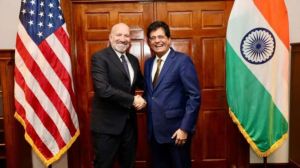To hold in Trust
Ccome February 1, and Unit Trust of India (UTI) — for decades synonymous with savings and investment activity in the country — wil...

Ccome February 1, and Unit Trust of India (UTI) — for decades synonymous with savings and investment activity in the country — will cease to exist in its present form, making way for two institutions, UTI-I and UTI-II.
The split, in many ways, marks the culmination of efforts to restore investor confidence in an institution used and abused by corporates and politicians for years. To be fair to UTI, the institution did serve its purpose over four decades in popularising the mutual fund culture among millions of Indians, but incorrect decisions and a woeful lack of foresight by successive managements led to its decline.
Added to this was the negligence of the government and confusing signals emanating from North Block on the parentage of the Trust. Over many years, UTI continued to dish out attractive sale and repurchase prices for its flagship scheme, US-64, which were completely out of sync with the market in which it operated, and not linked to its net asset value. In fact, the NAV itself was the subject of much speculation and continued to be shrouded in mystery. By the time corrective action began, it was too late: the NAV had slumped and the market was in the midst of a prolonged bear phase.
Credit, however, must go to finance minister Jaswant Singh and the present UTI management for attempting a brave recovery of the Trust through the split. A hugely market-sensitive move, the decision to carve out two UTIs from one, needed not just courage but also foresight. Consequently, UTI-I will now be the ‘sick bay’ housing the administered part of US-64 and assured return schemes. This will require a different regimen, and hence the need for an administrator and not a mere chief executive officer. UTI-II, on the other hand, will now become UTI Mutual Fund, the market-linked, NAV-based fund house, which can come up with new schemes and will be fully Securities and Exchange Board of India compliant.
But while implementing the two-UTI regime, the government must ensure two things. As recommended by the Joint Parliamentary Committee probing the stocks scam of 2001 UTI-II, which will have all the staff and expertise of fund management, must be given the task of managing UTI-I’s assets, so that even while the UTI-I schemes are gradually phased out, the assets of the administered schemes are managed well.
The two UTIs must function closely so that the best value can be derived from the huge equity holdings which the two entities have in scores of blue-chip corporations. Only by combining their strengths can each achieve what is best for them and their investors.
UTI-II, on its part, will have its task cut out, since with an asset base of around Rs 15,000 crore, it still is the largest mutual fund house in the country after UTI-I. By ensuring that past mistakes are not repeated and managing its assets well, UTI-II can, at a later stage, command a healthy premium later when the government seeks to exit it totally.





- 01
- 02
- 03
- 04
- 05


























